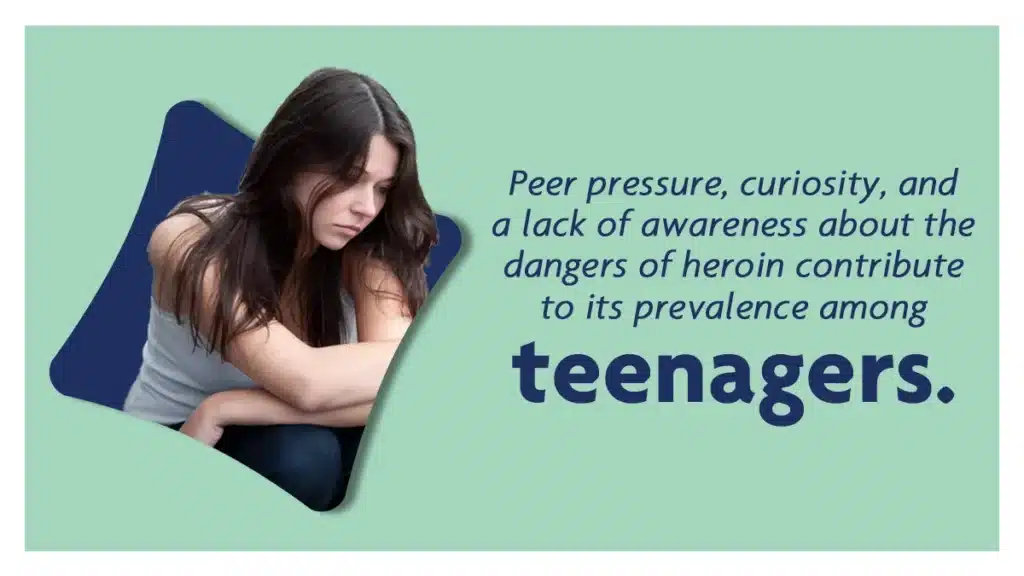Heroin, a potent opioid, holds a dangerous allure for teenagers, presenting a serious threat to their well-being. From its addictive nature to its devastating impact on physical and mental well-being, awareness is the first line of defense.
Unmasking the reality of heroin can help teenagers with the knowledge to make informed choices, navigate challenges, and steer clear of the hazardous path that heroin poses to their futures.
Key Takeaways
Cooperation between parents, educators, and healthcare professionals is essential in identifying and addressing the signs of heroin use in teens. Here’s what you need to know:
- Heroin use among teenagers poses a severe risk to their physical and mental health, leading to overdose and addiction.
- Peer pressure, curiosity, and a lack of awareness about the dangers of heroin contribute to its prevalence among teenagers.
- Open communication and education about the devastating effects of heroin can empower teenagers to make healthy choices.
Visit our website or contact us at (845) 479-6888 for more information and medical help.
Brief History of Heroin
Heroin is a powerful opioid drug derived from morphine, a natural substance extracted from the seed pod of the opium poppy. It was first synthesized in the late 19th century as a semi-synthetic derivative of morphine.
Initially marketed by Bayer as a non-addictive substitute for morphine, it soon revealed its addictive nature. By the early 20th century, heroin abuse soared, leading to restrictive regulations.
The substance played a tragic role in the mid-20th century with the rise of the heroin epidemic, notably in urban areas.
Science of Heroin
Heroin, scientifically known as diacetylmorphine, belongs to the opioid family. It undergoes a chemical process that increases its potency and ability to cross the blood-brain barrier.
This enhanced form of the illicit drug results in intense and rapid euphoria, making it highly addictive.
Chemical Composition
Heroin’s chemical structure is a modified version of morphine, with acetyl groups added. These alterations enhance solubility and potency, leading to faster and more intense effects on the central nervous system.
How Heroin Affects the Brain
Upon entering the bloodstream, heroin rapidly crosses the blood-brain barrier, converting back into morphine. Once in the brain, it binds to opioid receptors, disrupting normal neurotransmitter function.
This interference induces a surge of dopamine, creating a powerful sense of pleasure and relaxation. Unfortunately, repeated use leads to tolerance and dependence, contributing to the cycle of addiction.
Short-Term Effects
Heroin use can lead to immediate health challenges for those who use it. Short-term effects include extreme euphoria, drowsiness, and impaired mental function. Teenagers may also experience nausea, vomiting, increased heart rate, and severe itching.
The risk of accidents increases due to slowed reflexes and coordination. Short-term use can quickly spiral into unprotected sex, hepatitis C, and drug addiction, affecting one’s daily life.
Long-Term Effects
Continued heroin use has detrimental long-term consequences on both physical and mental health. Teens with chronic use may suffer from collapsed veins, respiratory depression, and deteriorating overall health death.
Mental health struggles, including depression and anxiety, often accompany long-term use. Academic performance, relationships, and life goals can be severely impacted, leading to a downward spiral.
Risk of Overdose
Heroin use poses a grave risk of overdose, especially as tolerance builds over time. Overdose symptoms include shallow breathing, blue lips or nails, and unresponsiveness. Quick action, like administering naloxone and calling emergency services, can save a person’s life during an overdose.
Family members must understand the signs of opioid overdose in a child and help medical emergency help immediately.
Heroin Dependence and Withdrawal
The use of heroin can lead to a profound physiological dependence, where the body becomes reliant on the substance. When attempts are made to discontinue its use, withdrawal symptoms manifest. These symptoms, according to the National Institute on Drug Abuse, ranging from nausea to anxiety, reflect the body’s response to the absence of the drug.
Adolescents must comprehend the gravity of heroin use, as the consequences can be severe.
Treating Heroin Addiction in Teens
Heroin addiction is a significant challenge for teenagers, but effective treatment options are available. Exploring these treatment options is essential for breaking free from addiction.
Detox
Detox is the initial phase of treatment, focusing on the removal of pure heroin from the body. Medical professionals supervise this process to manage withdrawal symptoms safely. It is a crucial first step before entering into other forms of treatment.
Residential Treatment
Residential or inpatient treatment involves living in a treatment facility for an extended period. This immersive environment offers constant support and supervision. Teens engage in individual and group therapy sessions and educational activities and develop coping skills to address the root causes of heroin overdose.
Counseling and Therapy
Counseling or behavioral therapy is a supportive approach where a trained professional helps individuals explore the reasons behind their drug use. These sessions focus on developing healthier coping mechanisms and understanding the root causes of drug abuse.
Medication-Assisted Treatment (MAT)
Medication-assisted treatment (MAT) involves prescribed medications, such as methadone or buprenorphine. These medications can aid in reducing cravings and withdrawal symptoms. MAT is typically part of a broader treatment plan, often combined with counseling and therapy to prevent heroin-related deaths.

Preventing Heroin Addiction Among Teenagers
Preventing heroin use disorder among young people requires a multi-faceted and comprehensive approach that addresses various factors contributing to substance abuse.
Here are several strategies that can be implemented at different levels:
Explain the Risks
Highlight short-term and long-term consequences, like infectious diseases and legal troubles, to make the impact of heroin use more relatable. Teenagers tend to care more about social consequences than physical consequences at this age.
Open Communication
Encourage teens to share feelings and discuss peer pressure openly. Fostering this communication helps create a supportive environment and builds resilience to avoid heroin overdose.
Building Healthy Outlets
Engage teens in sports, arts, or other activities for constructive energy outlets, fostering self-esteem and keeping them away from health problems.
Inspiration from Success Stories
Share inspiring testimonials of those who successfully avoided street heroin. These stories are powerful motivators, emphasizing that prevention is achievable through smart choices and collective effort.
Frequently Asked Questions
Does fentanyl feel differently than heroin?
Yes, fentanyl and heroin produce similar effects, including euphoria and pain relief. However, fentanyl is much more potent than heroin, leading to a faster onset of intense but shorter-lasting effects. The differences in intensity and duration contribute to distinctions in the subjective experience between the two opioids.
How do you know if your heroin has fentanyl in it?
Detecting fentanyl in heroin without proper testing is challenging, as it is often added illicitly. Given the significant risks of a fentanyl overdose, it’s crucial to assume contamination. Testing kits or professional testing services can help identify fentanyl’s presence, providing a safer approach for those using or handling substances suspected of containing heroin.
What are some uses of heroin for medicinal purposes?
Heroin is not used for medicinal purposes due to its high potential for abuse and severe health risks. Instead, opioid medications like morphine or oxycodone are prescribed for pain management.
Heroin is an illegal, highly addictive drug with no approved medical use in most countries.
Helping Teens Overcome Heroin Addiction
Reclaim your teen’s future with our specialized teen treatment center committed to battling addiction, whether it’s alcohol, heroin, or other prescription drugs.
Our residential treatment program offers a unique blend of art and music therapy, educational workshops, recreational activities, and more, tailored to empower young minds on their journey to recovery.
Our skilled therapists empower teens to forge healthy coping mechanisms for a brighter tomorrow.
Your teen deserves a heroin-free life, and we are here to make it possible. Call us at (845) 479-6888 today.


